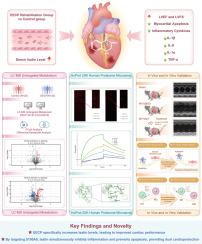在康复治疗为基础的代谢组学筛选后,升高的isatin可改善心肌梗死患者的心脏损伤
IF 8.3
1区 医学
Q1 CHEMISTRY, MEDICINAL
引用次数: 0
摘要
背景急性心肌梗死后进行康复性运动有助于心功能恢复。Isatin是色氨酸代谢的内源性吲哚衍生物,具有抗炎和抗氧化特性,但其在心肌梗死后心肌损伤修复中的作用尚不清楚。目的通过多组学方法探讨isatin对AMI康复后患者的心脏保护作用及其分子机制。本研究旨在通过非靶向代谢组学、HuProt™微阵列、网络药理学(NP)、表面等离子体共振(SPR)、分子对接、分子动力学(MD)、动物模型和细胞实验等手段,系统探讨isatin对AMI患者康复后心脏损伤的保护作用及其分子机制。方法采用非靶向代谢组学方法测定STEMI患者增强外反搏(EECP)康复前后血清isatin水平。利用HuProtTM芯片和NP鉴定isatin的下游靶点,并通过SPR、分子对接和动力学验证。采用小鼠AMI模型评价isatin的保护作用。利用h2o2处理的心肌细胞和lps处理的巨噬细胞探讨isatin的潜在保护机制。结果ecp升高STEMI患者血清isatin水平,与较好的心肺功能相关。通过HuProt™芯片和NP鉴定S100A8为主要靶点。Isatin与S100A8-GLU41形成2.1 Å氢键。SPR kd =57.9 μm;对接评分=−5.37 kcal/mol;MD ΔG=−15.35±1.95 kcal/mol。Isatin改善AMI小鼠心功能。Isatin提高HL-1心肌细胞活力,减少凋亡,降低巨噬细胞IL-1β、IL-6、IL-1α和TNF-α的分泌。结论本研究表明,EECP通过上调内源性isatin,促进STEMI患者心脏康复,isatin通过直接靶向S100A8发挥心脏保护作用,改善心功能,降低氧化应激和炎症,其分子机制通过多组学综合分析得到证实。本文章由计算机程序翻译,如有差异,请以英文原文为准。

Elevated isatin ameliorates heart injury in patients with myocardial infarction after rehabilitation treatment-based metabolomics screening
Background
Rehabilitation exercise after acute myocardial infarction is helpful for cardiac function recovery. Isatin, an endogenous indole derivative of tryptophan metabolism, exhibits anti-inflammatory and antioxidant properties, but its role in myocardial injury repair post-myocardial infarction (MI) remains unclear.
Purpose
This study aimed to investigate isatin's cardioprotective effects and molecular mechanisms in post-rehabilitation AMI patients through multi-omics approaches.
Study design
This study aimed to systematically investigate the protective effects and molecular mechanisms of isatin on cardiac injury in patients with AMI following rehabilitation, using untargeted metabolomics, HuProt™ microarray, network pharmacology (NP), surface plasmon resonance (SPR), molecular docking, molecular dynamics (MD), animal models, and cell experiments.
Methods
Serum isatin levels were measured in STEMI patients’ pre-/post-Enhanced external counterpulsation (EECP) rehabilitation using untargeted metabolomics. HuProtTM microarray and NP was used to identify the downstream targets of isatin, validated through SPR, molecular docking, and dynamics. A murine AMI model was applied to assess the protective function of isatin. H2O2-treated cardiomyocytes and LPS-treated macrophages were used to explore the potential protective mechanisms of isatin.
Results
EECP elevated serum isatin in STEMI patients, correlating with better cardiopulmonary function. S100A8 was identified as the primary target by HuProt™ microarray and NP. Isatin formed a 2.1 Å hydrogen bond with S100A8-GLU41. SPR KD=57.9 μM; Docking score=−5.37 kcal/mol; MD ΔG=−15.35 ± 1.95 kcal/mol. Isatin improved cardiac function in AMI mice. Isatin enhanced HL-1 cardiomyocyte viability while reducing apoptosis, and decreased macrophage IL-1β, IL-6, IL-1α, and TNF-α secretion.
Conclusion
This study demonstrates that EECP enhances cardiac rehabilitation in STEMI patients by upregulating endogenous isatin, which exerts cardioprotective effects through direct targeting of S100A8, leading to improved cardiac function and reduced oxidative stress and inflammation, with the molecular mechanism confirmed by integrated multi-omics analyses.
求助全文
通过发布文献求助,成功后即可免费获取论文全文。
去求助
来源期刊

Phytomedicine
医学-药学
CiteScore
10.30
自引率
5.10%
发文量
670
审稿时长
91 days
期刊介绍:
Phytomedicine is a therapy-oriented journal that publishes innovative studies on the efficacy, safety, quality, and mechanisms of action of specified plant extracts, phytopharmaceuticals, and their isolated constituents. This includes clinical, pharmacological, pharmacokinetic, and toxicological studies of herbal medicinal products, preparations, and purified compounds with defined and consistent quality, ensuring reproducible pharmacological activity. Founded in 1994, Phytomedicine aims to focus and stimulate research in this field and establish internationally accepted scientific standards for pharmacological studies, proof of clinical efficacy, and safety of phytomedicines.
 求助内容:
求助内容: 应助结果提醒方式:
应助结果提醒方式:


